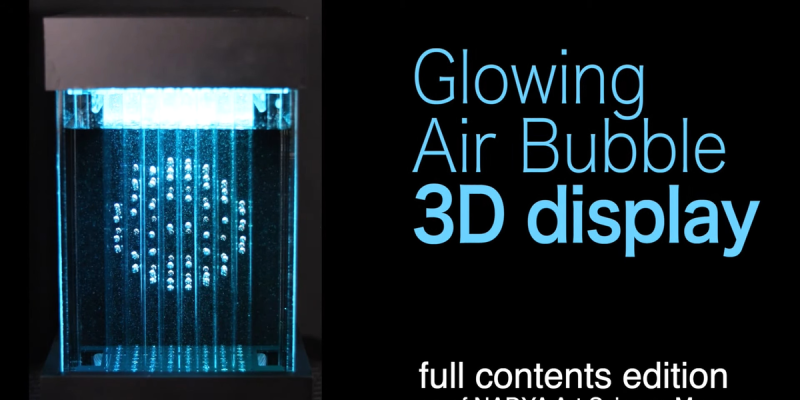When you work in a medium for long enough, and you learn how it works more and more deeply, you eventually become its master. [Yukio Shinoda] is probably master of the LED bubble display.
She started out with an idea, back in 1994, of a column of water and an array of solenoids to inject air, making patterns in the bubbles. Time passed, and she began to realize these works, first in water and then switching over to glycerine for slower, more predictable, and more spherical bubbles. The latest version realizes her initial vision, after 29 years, with an 8×8 array of nozzles making 3D shapes in the slowly rising columns.
To get a feel for the different stages of incremental progress, you really should watch all the videos, of version 1 in water, version 2 in glycerin, version 3 with fonts and FFT mode, and finally version 4 in 3D, embedded below.
It looks easy on paper: inject bubbles in to the fluid in time, and you get patterns. But the details here include separate tubes for each bubble, to prevent them from interacting, and careful attention to the timing. Indeed, the bubble clock has to adjust itself continually to take the viscosity of the glycerine into account, which changes with temperature in this video demo. Conveniently, the common DS3231 clock modules also have a temperature sensor built in, making this all a matter of code.
The soft clicking of the solenoids are reminiscent of flip-dot displays, but the slow rise of the bubbles is more meditative. And while the precision of the later models is admirable, we definitely also love the jumpy effect in the water version when a new bubble is introduced and the air pressure settles into its new circumstances. Fun stuff!
Is this the first bubble display we’ve seen? Not by a long shot. And it’s not the biggest or the simplest. But as far as we’re concerned, it’s one of the most refined, relaxing, and most evolved. But we have to admit, we’re also looking forward to version 5. What’s next?















That’s actually pretty.
Agree,
But I found the changing colors a distraction to “reading” the bubbles.
I feel the same way about tinsel
I actually have something like that. Tinsel floating in a liquid, with RGB leds rotating through. You shake the whole thing.
Can we do a REALLY slow one using lava-lamp technology (immiscible liquids with a small density difference)?
If you want to see a three-story-tall 96-tube version of this built in 1996, go to the Ontario Science Centre.
References: Brice Shapiro’s Pipedream III https://www.taomc.com/pipe-dream
https://hackaday.io/project/496-a-3-story-tall-96-tube-bubble-printer
Documentation of the build: http://bobodyne.com/web-docs/robots/OSC/
Cool! I linked that one in (under “the biggest”) above, but had never seen the build images.
That just makes me more interested about what he’s doing with those “tuning sections” in the tubes.
I wonder about having a very fast uniform flow of water or a more viscose fluid, so you can make the bubbles stay still. Or perhaps just have very fast bubbles and use persistence of vision. It’s about time we started to see 3d versions of these bubble displays.
@CRJEEA Maybe glass beads floating on air in tubes would look the same but allow for fast action.
You could reset things by blasting them out of the top and have a collection of new ones fed in at the bottom.
You’d need very precise airflow control though.
Hi, Elliot Williams
Thanks for the great article about my project Glowing Air-Bubble 3D display.
And thank you for introducing Pipedream III of the Ontario Science Centre. I am so impressed by the perfect image display with such vertical dimensions and resolution.I speculate that by injecting air bubbles into the tube, the degree of freedom of movement of the air bubbles can be well controlled.
In my work, although there is a rough separation for each nozzle, the bubbles coming out of the same nozzle do not affect each other and move freely with each other. It leads to a different way of crumbling on each time. Maybe it’s because I’m Japanese, but I think it’s positive. I seem it as an essential characteristic different from electronic digital displays.
After all, the 3D display is different from the 2D videos on YouTube, so I would like to hear your impressions after seeing it on real site. I would be happy if you could feel ZEN :)
Some people said that seeing my work reminded them of an aquarium they had seen in the past with many small jellyfish floating in the water.
I also want to go to the Ontario Science Center to see the Pipedream III. It’s perfectly controlled, so from the video it looks like a giant digital screen, but I’d like to see the movements of individual bubbles on site.
sorry for my poor English, but thanks to Google Translator.